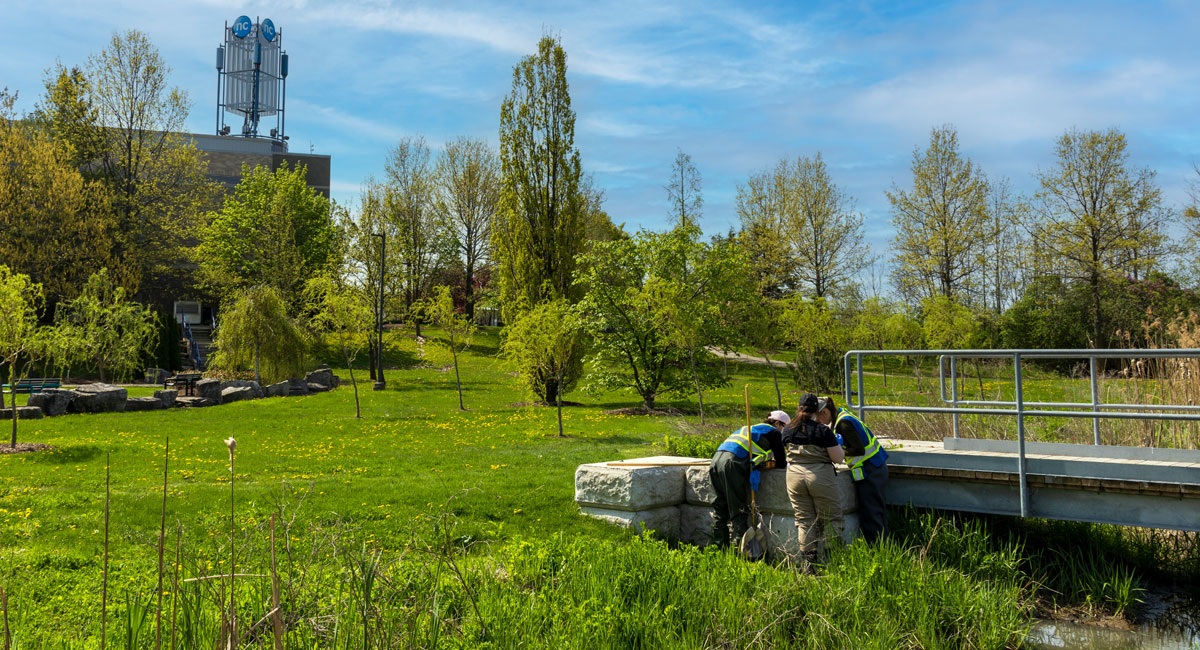Area of Focus: Built and Natural Environment

This area of focus outlines several core priorities, with goals and targets associated with each priority. These can be found in the Goals and Targets section below. The Actions table lists the actions that we plan to take to achieve our goals and targets. Every action in the actions table has additional information associated with it that connects that action to sustainability efforts. Scroll down to begin exploring this Area of Focus, or use the menu below to jump to a specific section.
Jump to:
Message of Support

My passion for sustainability stems from its interconnective nature; what we do locally results in a global impact and although that can have catastrophic results, how beautiful of an opportunity can it be to initiate global regeneration and contribute to global reductions of greenhouse gases. Much like this plan, sustainability touches everything; every industry, every demographic, every animal, plant, human, insect and to have the opportunity to drive change, to improve quality of life, and to contribute to the regrowth of mother nature is a privilege. It is my pleasure to endorse this plan, to make it the center focus of every decision and to participate in its implementation. I give gratitude to the passionate individuals that have authored this plan and to every school, department, and individual’s pledges to achieve the goals and targets within it.
Goals and Targets
Core Priority: Biodiversity
- Goal 4.1 Achieve no net loss of biodiversity by promoting the value of biodiversity and ecological services on campus and in the community.
- Target 4.1a Support the genetic diversity of wild and domesticated species populations, safeguarding adaptive potential1.
- Target 4.1b Increase species monitoring to identify and maintain a detailed biodiversity inventory on-campus.
- Goal 4.2 Develop an invasive species management plan.
- Target 4.2a Establish a comprehensive baseline of invasive species on campus.
Core Priority: Land
- Goal 5.1 Support the natural and manicured environments to further the protection of natural capital and infrastructure on campus from the effects of climate change using nature-based solutions.
- Target 5.1a Have ecological restoration completed or underway on at least 30% of degraded ecosystems on campus2.
- Target 5.1b Increase traditional knowledge as a guiding principle for campus grounds management.
- Goal 5.2 Support mental, physical, and spiritual health by connecting people with the natural environment.
- Target 5.2a Increase the number of programs and events that support personal and professional health and wellness on campus.
Core Priority: Buildings
- Goal 6.1 Integrate sustainability into spaces on campus through inclusive and universal design, material selection, and construction for new buildings and renovations.
- Target 6.1a All renovation and upgrade projects evaluate sustainability impacts, including inclusive and universal design, resource recovery, energy and carbon.
- Goal 6.2 All new buildings and deep retrofits will be designed to meet Zero Carbon Standard3, Passive House Certification4, or other approved sustainability-related building standard.
Core Priority: Transportation
- Goal 7.1 Encourage sustainable transportation behaviours through the support of improved public transit and alternative transportation methods
- Goal 7.1a Increase bike storage availability at both campuses.
Biodiversity is fundamental to human well-being and a healthy planet, and economic prosperity for all people. including for living well in balance and in harmony with Mother Earth, we depend on it for food, medicine, energy, clean air and water, security from natural disasters as well as recreation and cultural inspiration, and it supports all systems of life on earth.
Did You Know?
67% of respondents say a college’s commitment to the environment would contribute to their decision to apply to or attend the school.Did you know that Niagara College maintains a biodiversity of species found on-campus? There are almost 1,000 species identified at the Niagara-on-the-Lake campus and annual bioblitz events, and anyone can contribute using iNaturalist!
SDGs in Action: SDG15
The NC Student Administrative Council has a Universal Bus Pass program (U-Pass), which enables eligible students the ability to ride all Niagara Regional Transit buses while they study at Niagara College. In 2023, NCSAC held a referendum (student vote) with result of 74% in favour of a U-Pass.
SDGs in Action: SDG11
Niagara College is located on the traditional territory of the Haudenosaunee and Anishinaabe peoples. You can use tools like Native Land Digital which strives to create and foster conversations about the history of colonialism, Indigenous ways of knowing, and settler-Indigenous relations, through educational resources such as the map and Territory Acknowledgement Guide.
— Native Land Territory Acknowledgement
SDGs in Action: SDG4
Actions
Tap and drag on table (mobile) or use horizontal scrollbar below the table (laptop) to view the full width of the table below.
| Action | Connected Priorities | Timeline | Lead | STARS in Action | SDGs in Action | Greening TVET in Action |
|---|---|---|---|---|---|---|
| Conduct feasibility study for sustainable transit opportunities such as car-share, bike-share, and shuttle services | Transportation | Medium-Term | Student Administrative Council | Operations (OP 17) | 10, 11, 13 | Campus, Community |
| Establish additional green spaces dedicated to reconciliation between Indigenous and non-Indigenous people and connecting with nature | Biodiversity, Land | Medium-Term | Indigenous Education, Sustainability | Innovation & Leadership (IN 39) | 10, 15 | Community, Culture |
| Expand the green roof spaces at both campuses | Land | Short-Term | Facilities | Operations (OP 4) | 7, 11 | Campus |
| Expand the pollinator gardens and seed harvesting opportunities in campus and with the community | Biodiversity | Long-Term | Facilities, School of Environmental and Horticultural Studies | Operations (OP 10) | 2, 15 | Campus |
| Implement a comprehensive management plan for invasive species, including phragmites | Biodiversity, Land | Short-Term | Grounds Working Group | Operations (OP 10) | 15 | Campus |
| Implement an indoor and outdoor air quality monitoring program | Buildings, Land | Medium-Term | Facilities, School of Environmental and Horticultural Studies | Operations (OP 2, OP 4) | 3 | Campus |
| Establish an accessibility design standard, and implement annual accessibility audits to engage community members to ensure diverse needs of the NC community are met. | Buildings | Short-Term | Planning, Capital Projects | Engagement (EN 10) | 10 | Campus, Community |
| Incorporate bird-friendly design into all new capital construction, and renovations, and review opportunities to incorporate into existing spaces | Buildings, Biodiversity | Medium-Term | Planning, Sustainability, Capital Projects | Operations (OP 3) | 11, 15 | Campus |
| Increase the indoor green spaces and outdoor accessible green gathering spaces | Buildings, Biodiversity | Medium-Term | Facilities, School of Environmental and Horticultural Studies | Operations (OP 4) | 3, 4, 11 | Campus |
| Increase total number of bike racks available, including covered lockable bike storage | Transportation | Short-Term | Sustainability, Facilities | Operations (OP 17) | 9, 11 | Campus |
| Develop and implement the Indigenous Garden Guide, incorporating culturally significant language and plants | Biodiversity, Land | Short-Term | Indigenous Education, Sustainability | Innovation & Leadership (IN 10, 15) | 10, 15 | Campus, Culture |
| Update biodiversity inventory, including an emphasis on underrepresented species and incorporating the cultural significance of species | Biodiversity, Land | Long-Term | Sustainability, School of Environmental and Horticultural Studies | Operations (OP 10), Innovation & Leadership (IN 39) | 14, 15 | Campus |
| Update the campus tree inventories to quantify the attributed carbon sequestration | Biodiversity, Grounds, Carbon Emissions | Medium-Term | Sustainability, School of Environmental and Horticultural Studies | Operations (OP 2) | 11, 13 | Campus |
| Update the project planning process for renovations and capital projects to integrate sustainability-related indicators, including material selection | Buildings, Procurement, Carbon Emissions, Energy | Short-Term | Planning, Sustainability, Capital Projects | Operations (OP 3) | 9 | Campus |
Niagara College is nestled in the heart of the Dish with One Spoon territories; the Sustainability Plan includes these values of sharing and reciprocity with the lands in the way we conduct ourselves as a place of higher learning. The plan talks about how the land can’t be owned, and how we are connected as living beings. Actualizing this sense of caring and responsibility to place will help plant the seeds upon which we can build a truly strong foundation for Indigenous students and communities.
— NC Indigenous Education
Stories
Niagara College’s Grounds Working Group
In 2023, a new Grounds Working Group was formed as a cross-functional collaboration to support academic planning, maintain grounds in line with the Master Plan and Sustainability Plan, optimize resources, and communicate and engage with the NC community. The group is chaired by the Senior Director, Academic Transformation Initiatives, and has representatives from the School of Environmental and Horticultural Studies, Facilities Management and Campus Safety, Planning, Sustainability and Capital Projects, and Financial Services.
SDGs in Action: SDG16, SDG17
Living Library Event with Adam Shoalts
In 2022, the Niagara College Libraries, School of Environmental and Horticultural Studies, and NC Sustainability partnered for the Fall Living Library event with national best-selling author Adam Shoalts, sharing his experience as a professional explorer in some of the most remote wilderness areas.
SDGs in Action: SDG4, SDG17
NC WVEC’s Sustainable Winegrowing Ontario Certification
In 2022, Niagara College’s Wine Visitor and Education Centre (WVEC) achieved the Sustainable Winegrowing Ontario Certification, focusing on water and waste management, energy efficiencies, social responsibility, commitment to diversity in the workplace (and more) to ensure that the complete grape-to-glass path is sustainable.
SDGs in Action: SDG2, SDG8, SDG17
References
1 In line with targets from the Convention on Biological Diversity: Kunming-Montreal Global Biodiversity Framework. Retrieved from COP15: Nations Adopt Four Goals, 23 Targets For 2030 In Landmark Un Biodiversity Agreement
2 Passive House Canada; https://www.passivehousecanada.com/about-passive-house-canada/
3 Zero Carbon Building Standards from the Canada Green Building Council; Link: https://www.cagbc.org/our-work/certification/zero-carbon-building-standard/#:~:text=CAGBC’s%20Zero%20Carbon%20Building%E2%84%A2,in%20reaching%20national%20climate%20commitments.
4 Passive House Canada; Link: https://www.passivehousecanada.com/about-passive-house-canada/
5 Thermal Energy Demand Intensity (TEDI) is the annual heat loss from a building’s envelope and ventilation after accounting for all passive heat gains and losses, per unit of modelled floor area. Zero Carbon Building (Design Version 3): Energy Modelling Guidelines. (2022). Canada Green Building Council. Retrieved from https://www.cagbc.org/wp-content/uploads/2022/06/ZCB-Design_v3_energy_modelling_guidelines.pdf.
Goals and Targets
- Each Area of Focus outlined above identifies several Core Priorities.
- Goals and Targets are associated with each Core Priority.
Actions
- Actions will help us achieve our Goals and Targets and are provided in an Actions table.
- Multiple Actions are associated with each Core Priority.
Actions Tables
Every Action has columns of additional information that connects that Action to sustainability efforts. These columns of information are explained below.
Connected Priorities
Connected Priorities identify the Core Priorities this action impacts to help illustrate the interconnection of single actions.
Timeline
Timeline outlines the approximate time frame it will take to implement this action. The timelines are defined as:
- Short-term: 1-2 years
- Medium-term: 3-5 years
- Long-term: 5+ years
Lead
Lead identifies the Niagara College Departments and Schools that will provide leadership to support the implementation of this action, with the support from respective Directors, and Executive Team members. The success of these actions is a combined effort between all members of the Niagara College community. We need to collectively work together to support the Leads directly and indirectly.
STARS in Action
STARS in Action identifies the Sustainability Tracking, Assessment & Rating System (STARS) credits from the Association for the Advancement of Sustainability in Higher Education (AASHE) that Action aligns with.
SDGs in Action
SDGs in Action identify the United Nations Sustainable Development Goals that this Action positively impacts. Learn more about how NC is impacting the SDGs.
GTVET in Action
GTVET in Action identifies the Greening Technical Vocational Education and Training (GTVET) Dimensions of Greening that each Action aligns with.
The United Nations Sustainable Development Goals (SDGs) are the layout to achieve a better and more sustainable future for all by 2030. Learn more about SDGs and access a learning module on the Sustainability website.
The 17 Sustainable Development Goals (SDGs) are:
- No Poverty
- Zero Hunger
- Good Health and Well-Being
- Quality Education
- Gender Equality
- Clean Water and Sanitation
- Affordable and Clean Energy
- Decent Work and Economic Growth
- Industry, Innovation and Infrastructure
- Reduced Inequalities
- Sustainable Cities and Communities
- Responsible Consumption and Production
- Climate Action
- Life Below Water
- Life on Land
- Peace, Justice and Strong Institutions
- Partnerships for the Goals
